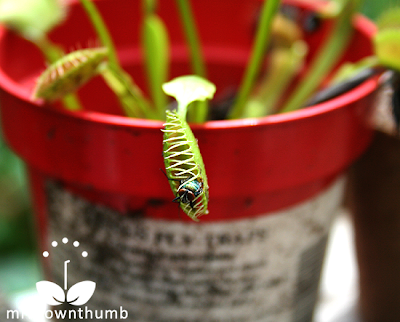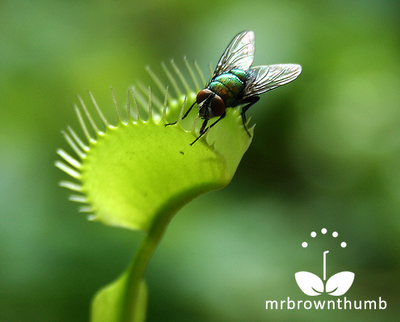The Venus Flytrap, scientific name Dionaea muscipula, is one of those plants that every couple of years ends up in my plant collection. Venus Flytrap care requirements aren't rocket surgery, but it is the one carnivorous plant that most people have trouble with. The Venus Flytrap I'm currently growing was a gift from a gardening friend. Another friend, not a gardener, called me couple of days ago to talk carnivorous plants. In the course of our conversation I mentioned the recent plant accquisition and how it hadn't caught any flies in the two weeks I have owned it. I even brought the Venus Flytrap indoors where I practically chased flies around the house shoving it at them saying, "Eat, Eat!" Today I decided to place the Venus Flytrap outdoors where I could take some pictures and perhaps it would catch an insect or two. Venus Flytrap pictures of it in action catching a fly in my container garden, below. My Venus Flytrap catches a fly, and I have pictures to prove it.
Almost as soon as I set the Venus Flytrap on the porch a fly landed on it. I didn't get too excited because this had happened several times indoors, always ending with the fly escaping. Most of the time flies used my Venus Flytrap as a perch. One evening as I was heading to bed I noticed four flies SLEEPING on my Venus Flytrap.
See what I mean? Another fly manages to escape from the jaws of death. This fly decides to rest on the Venus Flytrap and contemplate its next move.
Clearly my flytrap's reputation as a wuss proceeds it. After escaping the pad below the fly moved onto a taller pad on the same plant.
Clearly emboldened by its Houdini-like powers this fly decides to explore more of the pad.
Oh, snap! Literally. Om Nom Nom Nom. This time the fly didn't escape. As the fly struggles the pads close tighter around the fly. Now that my Venus Flytrap has caught a fly I'm officially giving it a name. Ladies and gentlemen meet, Francis.
Not only did Francis catch his first fly today he also decided to bloom. A dainty little white flower with five petals. Here is a picture of the Venus Flytrap flower that opened today. The flower stalk on this Venus Flytrap is about nine inches in length. The reason Venus Flytrap flowers grow so tall and away from the pads is so insects that visit the bloom don't land on the pads and become food.
To give you an idea of the size of the flower on this Venus Flytrap here's a pictures of a sweat bee foraging. You know how small sweat bees are, right? They're tiny bees that you probably see often flying around your garden but mistake for flies.
Growing a Venus Flytrap
Venus Flytraps are great plants to grow. Not only can they act like a natural method of pest control indoors they can be an educational tool for young gardeners. They're just plain fun to observe on a daily basis providing they're actually, you know, catching flies.Venus Flytraps grow best in poor, wet soils in full sun. Most of their nitrogen comes from the insects they trap and digest. The majority of people who ask me about growing flytraps want to know if you can feed a flytrap raw meet. It seems like a good option for carnivorous plants growing indoors, but giving a plant like a Venus Flytrap raw meet poses serious problems for the plant. As the meat decomposes inside of the trap it will produce bacteria that can rot the trap. The best way to feed a Venus Flytrap is to keep it outside where it will catch its own food. If you're growing a flytrap indoors find good-sized bug that isn't longer than the trap and trigger the hairs in the pad so the trap closes tightly.
Out of all of the carnivorous plants you could add your collection Venus Flytrap is probably the easiest of them all to grow. The growing requirements are easy enough that the blackest thumb can keep one alive. Full sun, humidity a bug once a month and you should have a healthy plant. If your Venus Flytrap flowers keep an eye out for seeds, they can be propagated by seeds and vegetatively.
How is your Venus Flytrap doing?
Related post:
Natural method of pest control using carnivorous plants.
Why is My Venus Flytrap Dying?
Carnivorous Pitcher Plant Eating Bugs.
Search
10.8.10
11 comments:
Hi!
Feel free to leave a comment. You can always use the search box for my blog or the search "Google For Gardeners" if you're looking for gardening information. If you're looking for seed saving information check out "Seed Snatcher"search engine.
Do not have a blog yourself? Comment using the "anonymous" feature. If you have a Twitter or FB account feel free to use the "Name URL" feature so other people can find you.
Thanks for visiting.
Subscribe to:
Post Comments (Atom)










My VFT, thank you for asking, survived being transplanted into a bigger pot. She's caught a lot of insects and I think it's cool how the section (pod? branch?) then turns black as it processes the bug. I don't however have a flower, or even a hint of one, and that's just not fair (pout pout) as the flower is really gorgeous. I'll have to show mine the photos of yours and tell mine "Flower! Flower!" And when she does, I'll name her Deanna.
ReplyDelete@Monica,
ReplyDeleteLMAO. Are you regretting giving me this plant instead of the other one because mine is flowering? Put her up against your computer screen and let her see what her brother, Francis, is up to and maybe she'll be inspired.
How dare flies sleep on your venus flytrap. I had a sundew that was supposed to catch fruitflies but like you I had to catch them myself and feed it. Maybe I was making him lazy? Was it me coddling him since seedlinghood? Humph. That spoiled brat of a sundew is now in the compost bin.
ReplyDeleteGlad to see your plant is starting to work for his dinner.
Francis has a good life there, messing with the flys! That first picture is fantastic!
ReplyDeleteThese are awesome shares today. Wouldn't it be cool to just sit all day snapping the bug world around us? I love your shots! Did you use the tri-pod? Your images are rocking it dude!
ReplyDeleteFrancis is so cool MBT! Maybe he has more discriminating tastes than lowly flies - hope he's not related to Audrey II. The blooms are beautiful. Fantastic photos.
ReplyDeleteI've never grown a carnivorous plant - looks like it would be fun to try one.
I love that you said Om Nom nom. How lucky to actually get a sequential shots of all the action! A lot of amateurs overfeed those things when they really don't need too much, and feeding them meat is a great way to rot them, so I'm glad you brought it up. Beautiful photos of the flowers too!
ReplyDeleteI'll eventually get some native pitcher plants to grow in my boggy yard, maybe someday I'll get a pitcher plant too.
I love my venus fly traps. However, I let one of them flower and the whole plant went to crap after because it used all of its energy on the flower. Since then, I've pinched them when they try to bloom.
ReplyDeletecool! I was so hoping it would catch the fly! I've played around with venus fly traps but I can never keep them alive.
ReplyDelete@Stevie, LOL at your sundew story.
ReplyDelete@Laura, Thanks, he's doing pretty rough right now on account of me leaving him alone for a week, but I hope he bounces back.
@Bren, Yes, spending all day doing garden photography would be ideal, no? I didn't use any equipment it was all hand-held.
@Garden Girl, They are fun. You should grow a carnivorous plant or two. Everyone should have one of these weird plants around.
@Rainforest Gardener, LOL. I was debating whether to add that or not. Glad someone got a laugh from it. Hope you get some of those native pitcher plants. Must be nice to live in an area where they can grow out in the yard.
@Kimberly, Sorry to hear that about your venus fly traps. Yeah, if you want them to live long letting go to seed is probably not the best option.
@Wendy, That's too bad. I hope your luck with venus fly traps improves and you're able to grow them.
That's really intresting! Im doing a project on this plant, and it is going pretty well. I liked hearing your story!
ReplyDelete